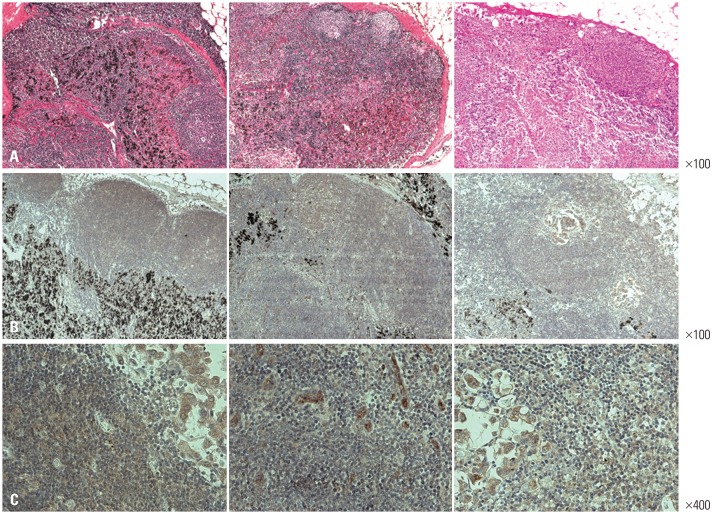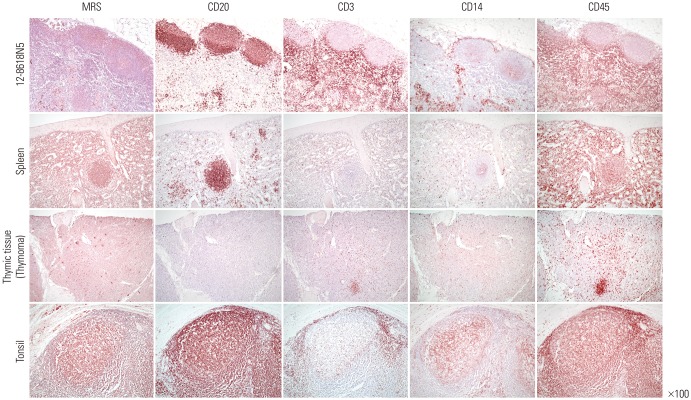Yonsei Med J.
2019 Nov;60(11):1005-1012. 10.3349/ymj.2019.60.11.1005.
Methionyl-tRNA Synthetase is a Useful Diagnostic Marker for Lymph Node Metastasis in Non-Small Cell Lung Cancer
- Affiliations
-
- 1Department of Internal Medicine, Yonsei University College of Medicine, Seoul, Korea. yschang@yuhs.ac
- 2Medicinal Bioconvergence Research Center, Department of Molecular Medicine and Biopharmaceutical Sciences, Graduate School of Convergence Technology, Seoul National University, Seoul, Korea.
- KMID: 2460216
- DOI: http://doi.org/10.3349/ymj.2019.60.11.1005
Abstract
- PURPOSE
Identification of lymph node (LN) metastasis in non-small cell lung cancer (NSCLC) is critical for disease staging and selection of therapeutic modalities. Sometimes it is not possible to obtain LN core tissue by endobronchial ultrasound-guided transbronchial needle aspirate (EBUS-TBNA), resulting in low diagnostic yield.
MATERIALS AND METHODS
In this study, 138 specimens were collected from 108 patients who underwent EBUS-TBNA under the suspicion of LN metastasis of NSCLC. Diagnostic yields of anti-CD45 and anti-methionyl-tRNA synthetase (MRS), immunofluorescent (IF) staining on cytology specimens were compared with those of conventional cytology and positron emission tomography-computed tomography (PET-CT).
RESULTS
MRS was strongly expressed in NSCLC cells metastasized to LNs, but weakly expressed in cells at the periphery of the LN germinal center. The majority of cells were CD20 positive, although a few cells were either CD3 or CD14 positive, indicating that CD45 staining is required for discrimination of non-malignant LN constituent cells from NSCLC cells. When the diagnostic efficacy of MRS/CD45 IF staining was evaluated using 138 LN cellular aspirates from 108 patients through EBUS-TBNA, the sensitivity was 76.7% and specificity was 90.8%, whereas those of conventional cytology test were 71.8% and 100.0%, respectively. Combining the results of conventional cytology testing and those of PET-CT showed a sensitivity and specificity of 71.6% and 100%, and the addition of MRS/CD45 dual IF data to this combination increased sensitivity and specificity to 85.1% and 97.8%, respectively.
CONCLUSION
MRS/CD45 dual IF staining showed good diagnostic performance and may be a good tool complementing conventional cytology test for determining LN metastasis of NSCLC.
Keyword
MeSH Terms
-
Amino Acyl-tRNA Synthetases
Carcinoma, Non-Small-Cell Lung*
Complement System Proteins
Discrimination (Psychology)
Electrons
Germinal Center
Humans
Ligases
Lymph Nodes*
Methionine-tRNA Ligase*
Needles
Neoplasm Metastasis*
Sensitivity and Specificity
Amino Acyl-tRNA Synthetases
Complement System Proteins
Ligases
Methionine-tRNA Ligase
Figure
Reference
-
1. Torre LA, Bray F, Siegel RL, Ferlay J, Lortet-Tieulent J, Jemal A. Global cancer statistics, 2012. CA Cancer J Clin. 2015; 65:87–108. PMID: 25651787.
Article2. Siegel RL, Miller KD, Jemal A. Cancer statistics, 2017. CA Cancer J Clin. 2017; 67:7–30. PMID: 28055103.
Article3. National Lung Screening Trial Research Team. Aberle DR, Adams AM, Berg CD, Black WC, Clapp JD, et al. Reduced lung-cancer mortality with low-dose computed tomographic screening. N Engl J Med. 2011; 365:395–409. PMID: 21714641.
Article4. Horeweg N, van Rosmalen J, Heuvelmans MA, van der Aalst CM, Vliegenthart R, Scholten ET, et al. Lung cancer probability in patients with CT-detected pulmonary nodules: a prespecified analysis of data from the NELSON trial of low-dose CT screening. Lancet Oncol. 2014; 15:1332–1341. PMID: 25282285.
Article5. Infante M, Cavuto S, Lutman FR, Passera E, Chiarenza M, Chiesa G, et al. Long-term follow-up results of the DANTE trial, a randomized study of lung cancer screening with spiral computed tomography. Am J Respir Crit Care Med. 2015; 191:1166–1175. PMID: 25760561.
Article6. Aberle DR, Abtin F, Brown K. Computed tomography screening for lung cancer: has it finally arrived? Implications of the national lung screening trial. J Clin Oncol. 2013; 31:1002–1008. PMID: 23401434.
Article7. Evison M, Morris J, Martin J, Shah R, Barber PV, Booton R, et al. Nodal staging in lung cancer: a risk stratification model for lymph nodes classified as negative by EBUS-TBNA. J Thorac Oncol. 2015; 10:126–133. PMID: 25371076.
Article8. Trisolini R, Cancellieri A, Tinelli C, de Biase D, Valentini I, Casadei G, et al. Randomized trial of endobronchial ultrasound-guided transbronchial needle aspiration with and without rapid on-site evaluation for lung cancer genotyping. Chest. 2015; 148:1430–1437. PMID: 26158441.
Article9. Bonifazi M, Sediari M, Ferretti M, Poidomani G, Tramacere I, Mei F, et al. The role of the pulmonologist in rapid on-site cytologic evaluation of transbronchial needle aspiration: a prospective study. Chest. 2014; 145:60–65. PMID: 23846345.10. Kim S, You S, Hwang D. Aminoacyl-tRNA synthetases and tumorigenesis: more than housekeeping. Nat Rev Cancer. 2011; 11:708–718. PMID: 21941282.
Article11. Han JM, Jeong SJ, Park MC, Kim G, Kwon NH, Kim HK, et al. Leucyl-tRNA synthetase is an intracellular leucine sensor for the mTORC1-signaling pathway. Cell. 2012; 149:410–424. PMID: 22424946.
Article12. Yannay-Cohen N, Carmi-Levy I, Kay G, Yang CM, Han JM, Kemeny DM, et al. LysRS serves as a key signaling molecule in the immune response by regulating gene expression. Mol Cell. 2009; 34:603–611. PMID: 19524539.
Article13. Keller TL, Zocco D, Sundrud MS, Hendrick M, Edenius M, Yum J, et al. Halofuginone and other febrifugine derivatives inhibit prolyl-tRNA synthetase. Nat Chem Biol. 2012; 8:311–317. PMID: 22327401.
Article14. Kim EY, Jung JY, Kim A, Kim K, Chang YS. Methionyl-tRNA synthetase overexpression is associated with poor clinical outcomes in non-small cell lung cancer. BMC Cancer. 2017; 17:467. PMID: 28679377.
Article15. Kim JH, Lee C, Lee M, Wang H, Kim K, Park SJ, et al. Control of leucine-dependent mTORC1 pathway through chemical intervention of leucyl-tRNA synthetase and RagD interaction. Nat Commun. 2017; 8:732. PMID: 28963468.
Article16. Kwon NH, Kang T, Lee JY, Kim HH, Kim HR, Hong J, et al. Dual role of methionyl-tRNA synthetase in the regulation of translation and tumor suppressor activity of aminoacyl-tRNA synthetase-interacting multifunctional protein-3. Proc Natl Acad Sci U S A. 2011; 108:19635–19640. PMID: 22106287.
Article17. Dehm SM. mRNA splicing variants: exploiting modularity to outwit cancer therapy. Cancer Res. 2013; 73:5309–5314. PMID: 23970479.
Article18. Um SW, Kim HK, Jung SH, Han J, Lee KJ, Park HY, et al. Endobronchial ultrasound versus mediastinoscopy for mediastinal nodal staging of non-small-cell lung cancer. J Thorac Oncol. 2015; 10:331–337. PMID: 25611227.
Article19. Nayak A, Sugrue C, Koenig S, Wasserman PG, Hoda S, Morgenstern NJ. Endobronchial ultrasound-guided transbronchial needle aspirate (EBUS-TBNA): a proposal for on-site adequacy criteria. Diagn Cytopathol. 2012; 40:128–137. PMID: 22246929.20. Alsharif M, Andrade RS, Groth SS, Stelow EB, Pambuccian SE. Endobronchial ultrasound-guided transbronchial fine-needle aspiration: the University of Minnesota experience, with emphasis on usefulness, adequacy assessment, and diagnostic difficulties. Am J Clin Pathol. 2008; 130:434–443. PMID: 18701418.21. Hadchouel A, Wieland T, Griese M, Baruffini E, Lorenz-Depiereux B, Enaud L, et al. Biallelic mutations of methionyl-tRNA synthetase cause a specific type of pulmonary alveolar proteinosis prevalent on Réunion Island. Am J Hum Genet. 2015; 96:826–831. PMID: 25913036.
Article22. Sun Y, Hu G, Luo J, Fang D, Yu Y, Wang X, et al. Mutations in methionyl-tRNA synthetase gene in a Chinese family with interstitial lung and liver disease, postnatal growth failure and anemia. J Hum Genet. 2017; 62:647–651. PMID: 28148924.
Article23. Mallya V, Kumar SP, Meganathan P, Shivkumar S, Mehta R. The utility of ROSE (rapid on-site evaluation) in endobronchial ultrasound (EBUS)-guided transbronchial needle aspiration (TBNA): is the picture rosy? J Cytol. 2015; 32:230–233. PMID: 26811569.
Article24. Lee TK, Esinhart JD, Blackburn LD, Silverman JF. The size of small cell lung carcinoma cells. Ratio to lymphocytes and correlation with specimen size and crush artifact. Anal Quant Cytol Histol. 1992; 14:32–34. PMID: 1313679.25. Schmid C, Pan L, Diss T, Isaacson PG. Expression of B-cell antigens by Hodgkin’s and Reed-Sternberg cells. Am J Pathol. 1991; 139:701–707. PMID: 1656757.
- Full Text Links
- Actions
-
Cited
- CITED
-
- Close
- Share
- Similar articles
-
- Expression of p53 and nm23 Proteins in Non-Small Cell Lung Cancer
- CT findings of mediastinal lymph node metastasis in bronchogenic carcinoma of the lung: A comparative study of small cell carcinoma vs non-small cell carcinoma
- Supraclavicular Lymph Node Excision Biopsy in Patients with Suspected Supraclavicular Lymph Node Metastasis of Lung Cancer: Experience in a Tertiary Hospital
- Noninvasive Diagnosis of Mediastinal Metastasis of Lung Cancer
- The Ability of FDG Uptake Ratio and Glut-1 Expression to Predict Mediastinal Lymph Node Metastasis in Resected Non-small Cell Lung Cancer





